Rescuing the Forgotten Flora: Proposal of an Ornamental Native Plant Collection for a Botanical Garden in an Industrial Zone
Abstract
1. Introduction
2. Materials and Methods
3. Results
4. Discussion
5. Conclusions
Author Contributions
Funding
Institutional Review Board Statement
Data Availability Statement
Acknowledgments
Conflicts of Interest
References
- Mendoza-Ponce, A.; Estrada, F.; Campo, J.; Calderón, Ó.; del Carmen, M.A.; Ramírez, A. Historic Land-Use Dynamics and Future Projections in Mexico’s Valley Megalopolis. J. Land Use Sci. 2025, 20, 98–116. [Google Scholar] [CrossRef]
- Meléndez-Jaramillo, E.; Sánchez-Castillo, L.; Martínez, M.T.D.J.S.; Sánchez-Reyes, U.J. Vegetation Changes along an Urbanisation and Atmospheric Pollution Gradient in Mexico. Nat. Conserv. 2023, 54, 179–202. [Google Scholar] [CrossRef]
- Rzedowski, J.; Calderón de Rzedowski, G. Sinopsis numérica de la flora fanerogámica del Valle de México. Acta Bot. Mex. 1989, 8, 15–30. [Google Scholar] [CrossRef]
- Calderón de Rzedowski, G.; Rzedowski, J. Flora Fanerogámica del Valle de México, 1a Reimp.; Instituto de Ecología, A.C.; CONABIO: Pátzcuaro, Michoacán, México, 2005. [Google Scholar]
- Cibrian-Jaramillo, A.; Hird, A.; Oleas, N.; Ma, H.; Meerow, A.W.; Francisco-Ortega, J.; Griffith, M.P. What Is the Conservation Value of a Plant in a Botanic Garden? Using Indicators to Improve Management of ex Situ Collections. Bot. Rev. 2013, 79, 559–577. [Google Scholar] [CrossRef]
- Mounce, R.; Smith, P.; Brockington, S. Ex situ Conservation of Plant Diversity in the World’s Botanic Gardens. Nat. Plants 2017, 3, 795–802. [Google Scholar] [CrossRef]
- Granziera, P. Concept of the Garden in Pre-Hispanic Mexico. Gard. Hist. 2001, 29, 185–213. [Google Scholar] [CrossRef]
- Avilés, P. Seven Ways of Looking at a Mountain: Tetzcotzingo and the Aztec Garden Tradition. Landsc. J. 2006, 25, 143–157. [Google Scholar] [CrossRef]
- Achim, M. Urban Science in 18th-Century Mexico City. In A Companion to Viceregal Mexico City, 1519–1821; McCaa, R., Ed.; Wiley-Blackwell: Hoboken, NJ, USA, 2021; Volume 3, p. 353. [Google Scholar]
- Silva, M.T.P.; Cardona, C.C. La Etnobiología en México Vista a la Luz de las Instituciones de Investigación. Etnobiología 2021, 19, 6–28. [Google Scholar]
- Viccon-Esquivel, J.; Arias Montes, S.; Cristians Niizawa, S.; Hernández Peña, M.A.; Castro Castro, A.; Cetzal Ix, W.; Rivas Avendaño, M.; Escalante Castro, J.R.; Luna Zúñiga, J.G.; Díaz Toribio, M.H. México Megadiverso Visto a Través de sus Jardines y sus Protagonistas; AMJB/CONAHCYT: México City, México, 2023. [Google Scholar]
- Asociación Mexicana de Jardines Botánicos. Available online: https://amjb.abaco2.org/ (accessed on 15 October 2025).
- Błaszak, M.; Rybska, E.; Tsivitanidou, O.; Constantinou, C.P. Botanical Gardens for Productive Interplay between Emotions and Cognition. Sustainability 2019, 11, 7160. [Google Scholar] [CrossRef]
- Girmay, M. Roles of Botanical Gardens for Conservation and Requirements for Their Establishment. Daagu Int. J. Basic Appl. Res. 2023, 5, 182–192. [Google Scholar]
- Britton, N.L. Botanical Gardens. Science 1896, 4, 284–293. [Google Scholar] [CrossRef] [PubMed]
- Kendal, D.; Williams, K.J.; Williams, N.S. Plant Traits Link People’s Plant Preferences to the Composition of Their Gardens. Landsc. Urban Plan. 2012, 105, 34–42. [Google Scholar] [CrossRef]
- Hůla, M.; Flegr, J. What Flowers Do We Like? The Influence of Shape and Color on the Rating of Flower Beauty. PeerJ 2016, 4, e2106. [Google Scholar] [CrossRef]
- Wyse Jackson, P.S.; Sutherland, L.A. International Agenda for Botanic Gardens in Conservation; Botanic Gardens Conservation International: Surrey, UK, 2000. [Google Scholar]
- Raschke, A.B.; Pegram, K.V.; Melkonoff, N.A.; Davis, J.; Blackwell, S.A. Collaborative Conservation by Botanical Gardens: Unique Opportunities for Local to Global Impacts. J. Zool. Bot. Gard. 2022, 3, 463–487. [Google Scholar] [CrossRef]
- Jiménez-Noriega, M.; De la Rosa Tilapa, A. El Jardín Botánico de la Facultad de Estudios Superiores Cuautitlán: Espacio de Conservación y Enseñanza para la Zona Norte del Valle de México. In México Megadiverso Visto a Través de sus Jardines y sus Protagonistas; Viccon-Esquivel, J., Arias Montes, S., Cristians Niizawa, S., Hernández Peña, M.A., Castro Castro, A., Cetzal Ix, W., Rivas Avendaño, M., Escalante Castro, J.R., Luna Zúñiga, J.G., Díaz Toribio, M.H., Eds.; AMJB/CONAHCYT: México City, México, 2023; pp. 146–153. [Google Scholar]
- Almagro, A.C.; Davison, J.O.; Caloca, O.R. Viejos Patrones y Nuevos Esquemas de Concentración. Anál. Econ. 2002, 17, 161–183. [Google Scholar]
- Rojas, L.R.; Enciso, J.A.G. Evolución y Cambio Industrial en las Zonas Metropolitanas del Valle de México y de Toluca, 1993–2008. Anál. Econ. 2016, 31, 115–146. [Google Scholar]
- De la Rosa Tilapa, A.; Jiménez-Noriega, M.S. Jardín botánico de la Facultad de Estudios Superiores Cuautitlán: Centro de conservación de polinizadores y visitantes florales en el norte del valle de México. Herreriana 2023, 5, 21–26. [Google Scholar] [CrossRef]
- Langellotto, G.A.; Melathopoulos, A.; Messer, I.; Anderson, A.; McClintock, N.; Costner, L. Garden Pollinators and the Potential for Ecosystem Service Flow to Urban and Peri-Urban Agriculture. Sustainability 2018, 10, 2047. [Google Scholar] [CrossRef]
- Cárdenas-Valdovinos, J.G.; García-Ruiz, I.; Angoa-Pérez, M.V.; Mena-Violante, H.G. Ethnobotany, Biological Activities and Phytochemical Compounds of Some Species of the Genus Eryngium (Apiaceae), from the Central-Western Region of Mexico. Molecules 2023, 28, 4094. [Google Scholar] [CrossRef]
- Aguilar-Contreras, A.; Camacho Pulido, J.R.; Chino-Vargas, S.; Jacquez-Rios, P.; López-Villafranco, M.E. Plantas Medicinales del Herbario IMSS; Instituto Mexicano del Seguro Social: México City, México, 1998. [Google Scholar]
- Pérez-Muñoz, E.P.; Antunes-Ricardo, M.; Martínez-Ávila, M.; Guajardo-Flores, D. Eryngium Species as a Potential Ally for Treating Metabolic Syndrome and Diabetes. Front. Nutr. 2022, 9, 878306. [Google Scholar] [CrossRef] [PubMed]
- Lemus-De la Cruz, J.; Trejo-Hurtado, M.; Landa-Moreno, C.; Peña-Montes, D.; Landeros-Páramo, J.L.; Cortés-Rojo, C.; Saavedra-Molina, A. Antioxidant Effects of Silver Nanoparticles Obtained by Green Synthesis from the Aqueous Extract of Eryngium carlinae on the Brain Mitochondria of Streptozotocin-Induced Diabetic Rats. J. Bioenerg. Biomembr. 2023, 55, 123–135. [Google Scholar] [CrossRef] [PubMed]
- García-Sánchez, F.; López-Villafranco, M.E.; Aguilar-Rodriguez, S.; Aguilar-Contreras, A. Ethnobotany and Comparative Morpho-Anatomy of Tagetes Used in Nicolas Romero, State of Mexico. Bot. Sci. 2012, 90, 221–232. [Google Scholar] [CrossRef]
- Armas, K.; Rojas, J.; Peña, J. Características Botánicas, Distribución Geográfica y Propiedades Biológicas de Varias Especies del Género Tagetes L. (Asteraceae). Rev. Fac. Farm. 2013, 55, 26–42. [Google Scholar]
- Sánchez-Alejo, R.; Rangel-Villafranco, M.; Cristóbal-Sánchez, G.; Martínez-García, A.; Pérez-Mondragón, M. Sistematización del Conocimiento Tradicional Asociado al Uso de las Plantas Medicinales en una Comunidad Mazahua. Rev. Iberoam. Cienc. 2016, 3, 153–160. [Google Scholar]
- Martínez-López, G.; Palacios-Rangel, M.I.; Guízar Nolazco, E.; Villanueva Morales, A. Usos Locales y Tradición: Estudio Etnobotánico de Plantas Útiles en San Pablo Cuatro Venados (Valles Centrales, Oaxaca). Polibotánica 2021, 52, 193–212. [Google Scholar] [CrossRef]
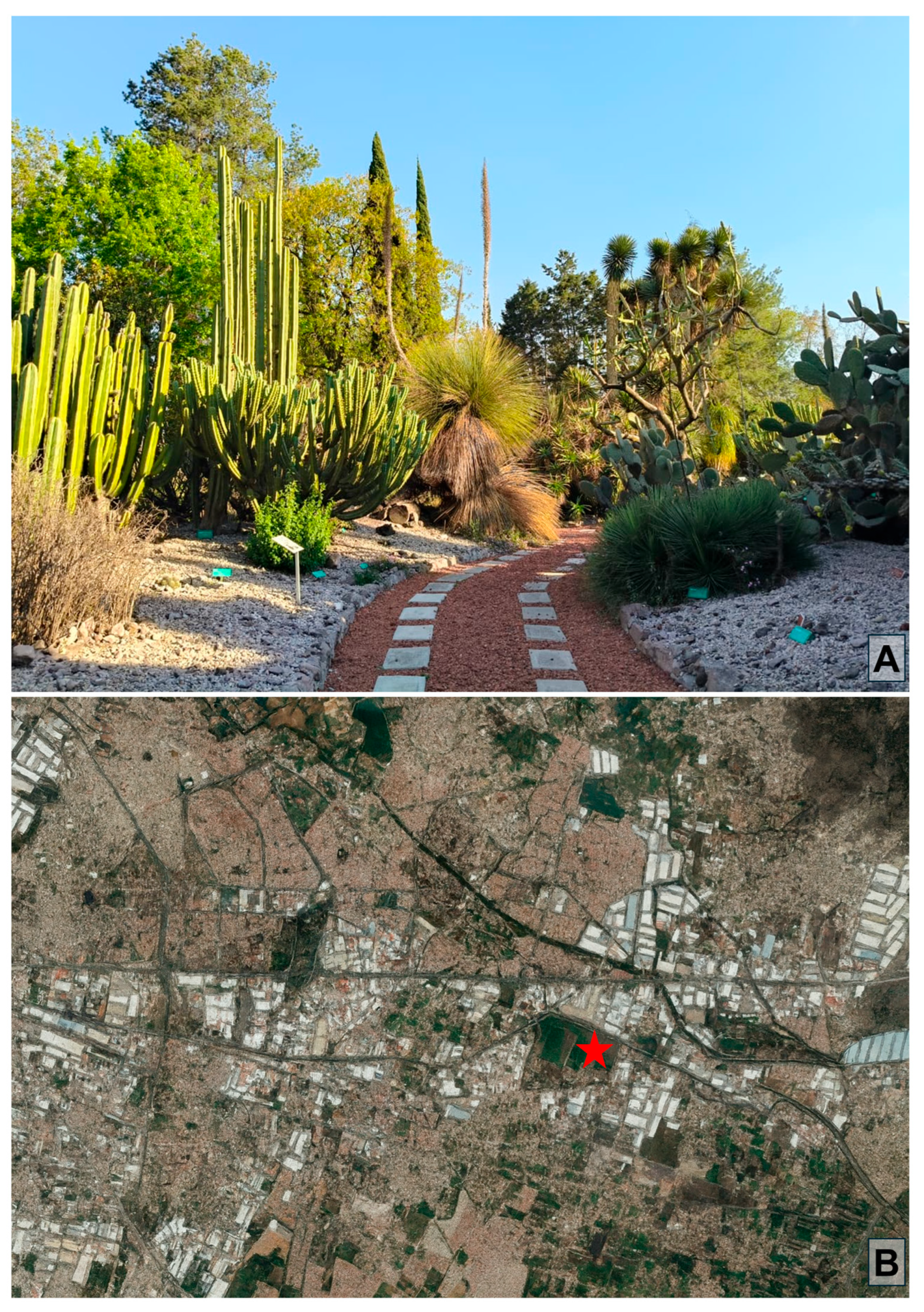
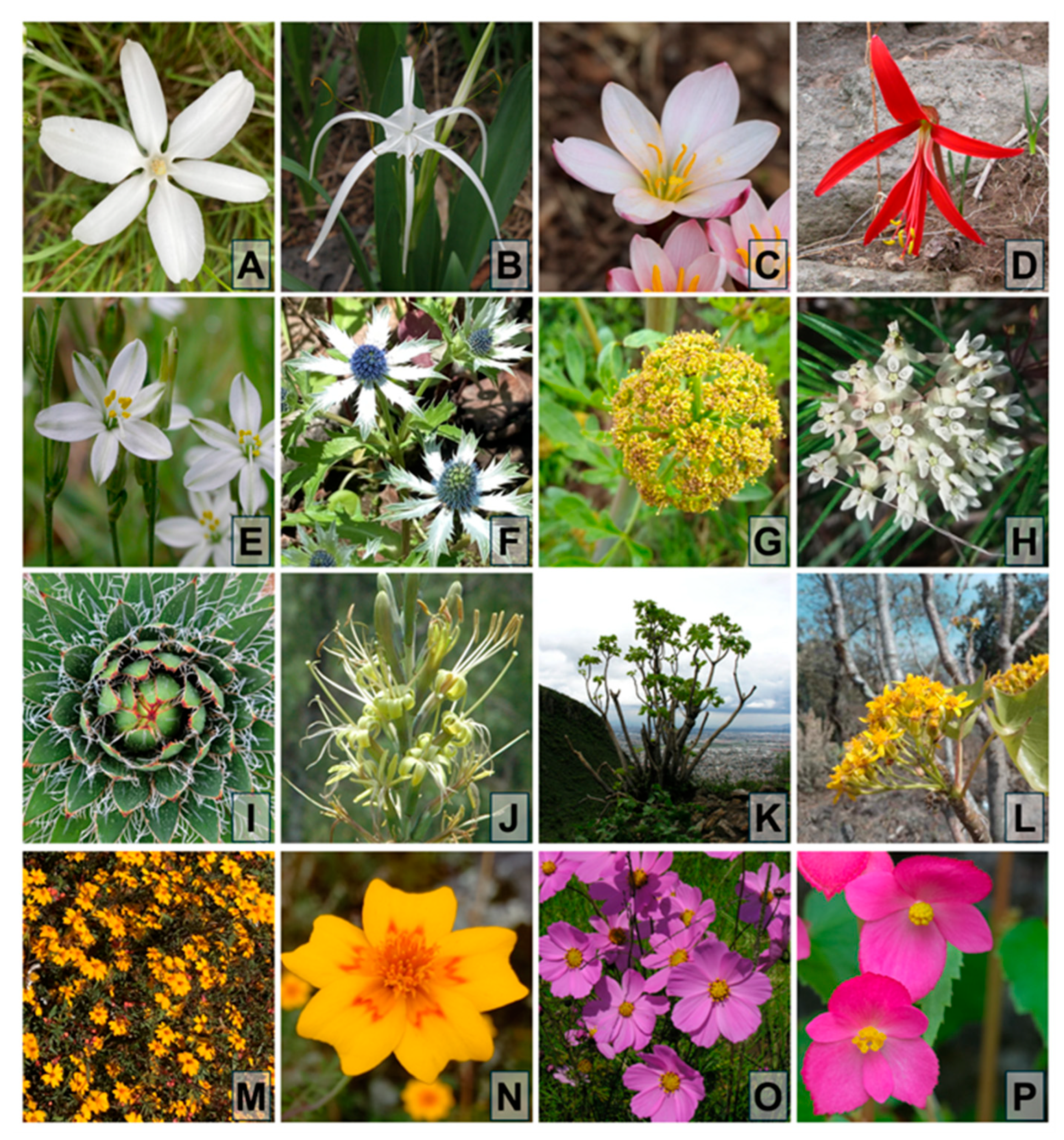
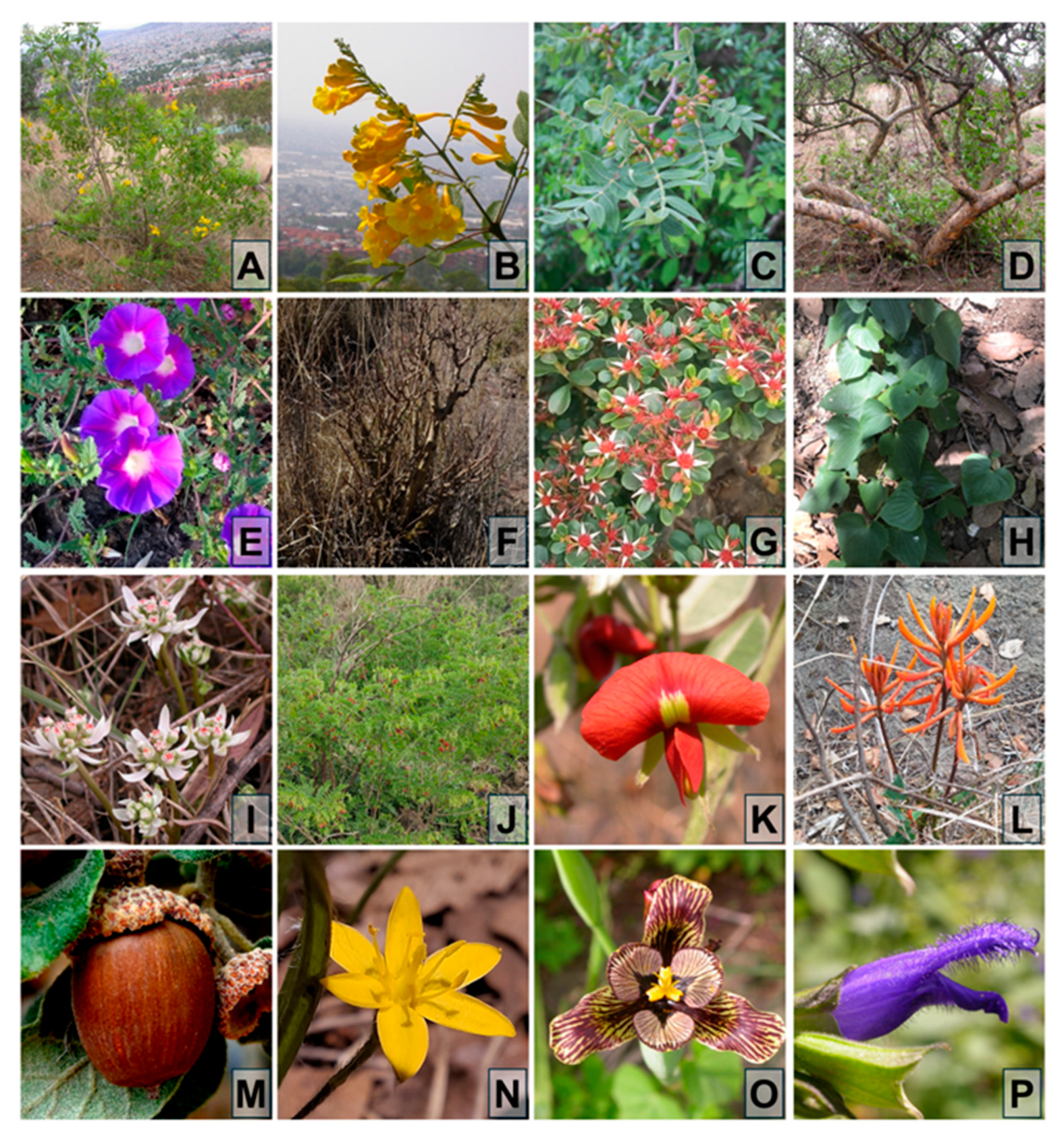
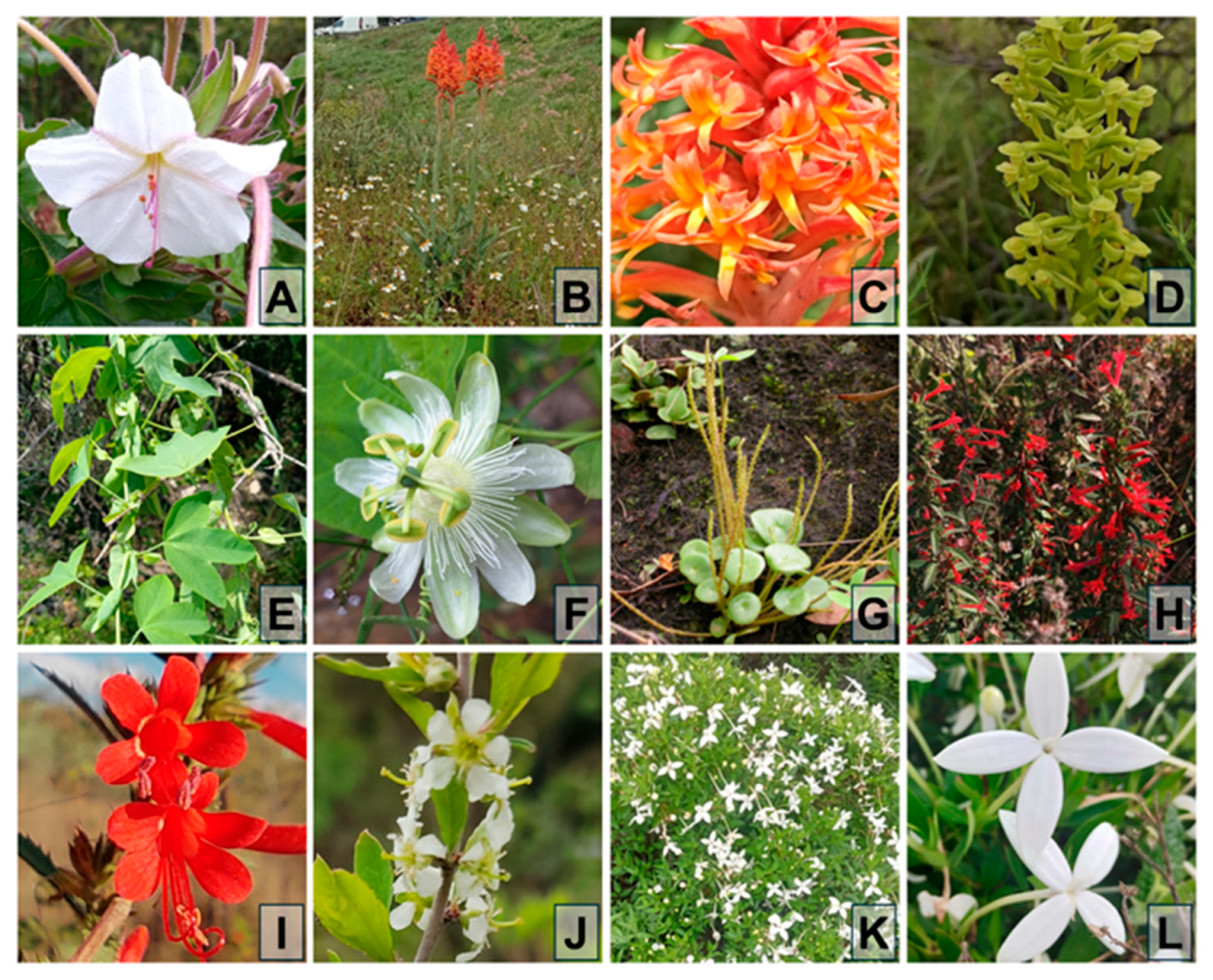
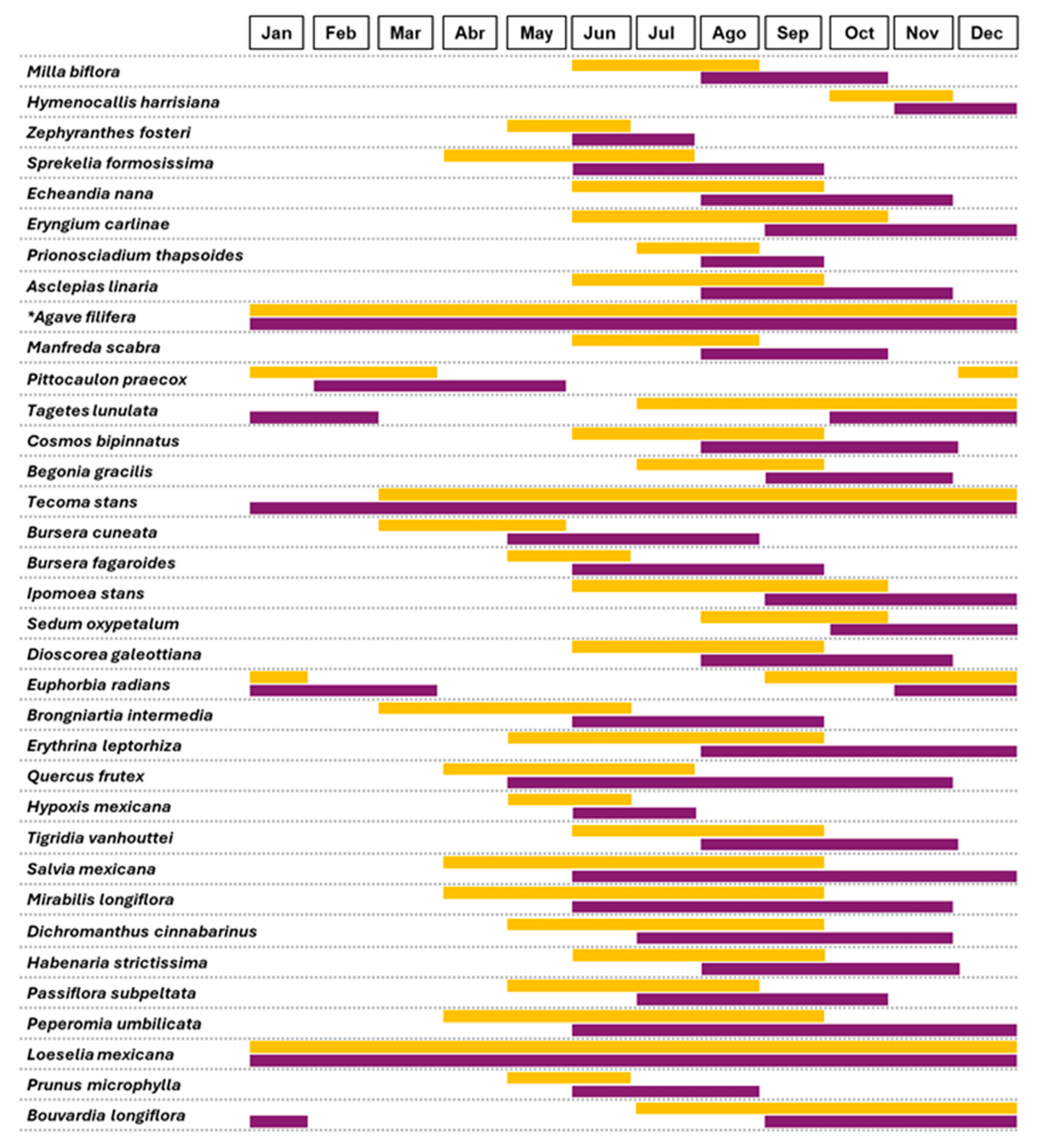

| Family | Species | Life Form | Phenology |
|---|---|---|---|
| Alliaceae | Milla biflora Cav. | Herbaceous | Perennial |
| Amaryllidaceae | * Hymenocallis harrisiana Herb. | Herbaceous | Perennial |
| Amaryllidaceae | * Zephyranthes fosteri Traub. | Herbaceous | Perennial |
| Amaryllidaceae | Sprekelia formosissima (L.) Herb. | Herbaceous | Perennial |
| Anthericaceae | * Echeandia nana (Baker) Cruden | Herbaceous | Perennial |
| Apiaceae | Eryngium carlinae F. Delaroche | Herbaceous | Annual |
| Apiaceae | Prionosciadium thapsoides (DC.) Mathias | Herbaceous | Perennial |
| Asclepiadaceae | Asclepias linaria Cav. | Shrub | Perennial |
| Asparagaceae | * Agave filifera Salm-Dyck | Herbaceous | Perennial |
| Asparagaceae | Manfreda scabra (Ortega) McVaugh | Herbaceous | Perennial |
| Asteraceae | * Pittocaulon praecox (Cav.) H. Rob. & Brettell | Shrub | Perennial |
| Asteraceae | * Tagetes lunulata Ortega | Herbaceous | Annual |
| Asteraceae | Cosmos bipinnatus Cav. | Herbaceous | Annual |
| Begoniaceae | Begonia gracilis Kunth | Herbaceous | Perennial |
| Bignoniaceae | Tecoma stans (L.) Juss. ex Kunth | Shrub | Perennial |
| Burseraceae | * Bursera cuneata (Schltdl.) Engl. | Tree | Perennial |
| Burseraceae | * Bursera fagaroides (Kunth) Engl. | Shrub | Perennial |
| Convolvulaceae | * Ipomoea stans Cav. | Shrub | Perennial |
| Crassulaceae | * Sedum oxypetalum Kunth | Shrub | Perennial |
| Dioscoreaceae | Dioscorea galeottiana Kunth | Vine | Perennial |
| Euphorbiaceae | Euphorbia radians Benth. | Herbaceous | Perennial |
| Fabaceae | * Brongniartia intermedia Moric. ex Ser. | Shrub | Perennial |
| Fabaceae | * Erythrina leptorhiza DC. | Shrub | Perennial |
| Fagaceae | * Quercus frutex Trel. | Shrub | Perennial |
| Hypoxidaceae | * Hypoxis mexicana Schult. & Schult. f. | Herbaceous | Perennial |
| Iridaceae | * Tigridia vanhouttei Roezl ex Van Houtte | Herbaceous | Perennial |
| Lamiaceae | * Salvia mexicana L. | Shrub | Perennial |
| Nyctaginaceae | Mirabilis longiflora L. | Shrub | Perennial |
| Orchidaceae | Dichromanthus cinnabarinus (Lex.) Garay. | Herbaceous | Perennial |
| Orchidaceae | Habenaria strictissima Rchb. f. | Herbaceous | Perennial |
| Passifloraceae | Passiflora subpeltata Ortega | Vine | Perennial |
| Piperaceae | Peperomia umbilicata Ruiz & Pav. | Herbaceous | Perennial |
| Polemoniaceae | Loeselia mexicana (Lam.) Brand. | Shrub | Perennial |
| Rosaceae | * Prunus microphylla (Kunth) Hemsl. | Shrub | Perennial |
| Rubiaceae | Bouvardia longiflora (Cav.) Kunth | Shrub | Perennial |
Disclaimer/Publisher’s Note: The statements, opinions and data contained in all publications are solely those of the individual author(s) and contributor(s) and not of MDPI and/or the editor(s). MDPI and/or the editor(s) disclaim responsibility for any injury to people or property resulting from any ideas, methods, instructions or products referred to in the content. |
© 2025 by the authors. Licensee MDPI, Basel, Switzerland. This article is an open access article distributed under the terms and conditions of the Creative Commons Attribution (CC BY) license (https://creativecommons.org/licenses/by/4.0/).
Share and Cite
Torres-Montúfar, A.; Jiménez-Noriega, M.S.; Quiñones-Molina, K. Rescuing the Forgotten Flora: Proposal of an Ornamental Native Plant Collection for a Botanical Garden in an Industrial Zone. J. Zool. Bot. Gard. 2025, 6, 54. https://doi.org/10.3390/jzbg6040054
Torres-Montúfar A, Jiménez-Noriega MS, Quiñones-Molina K. Rescuing the Forgotten Flora: Proposal of an Ornamental Native Plant Collection for a Botanical Garden in an Industrial Zone. Journal of Zoological and Botanical Gardens. 2025; 6(4):54. https://doi.org/10.3390/jzbg6040054
Chicago/Turabian StyleTorres-Montúfar, Alejandro, Mayte Stefany Jiménez-Noriega, and Karla Quiñones-Molina. 2025. "Rescuing the Forgotten Flora: Proposal of an Ornamental Native Plant Collection for a Botanical Garden in an Industrial Zone" Journal of Zoological and Botanical Gardens 6, no. 4: 54. https://doi.org/10.3390/jzbg6040054
APA StyleTorres-Montúfar, A., Jiménez-Noriega, M. S., & Quiñones-Molina, K. (2025). Rescuing the Forgotten Flora: Proposal of an Ornamental Native Plant Collection for a Botanical Garden in an Industrial Zone. Journal of Zoological and Botanical Gardens, 6(4), 54. https://doi.org/10.3390/jzbg6040054





